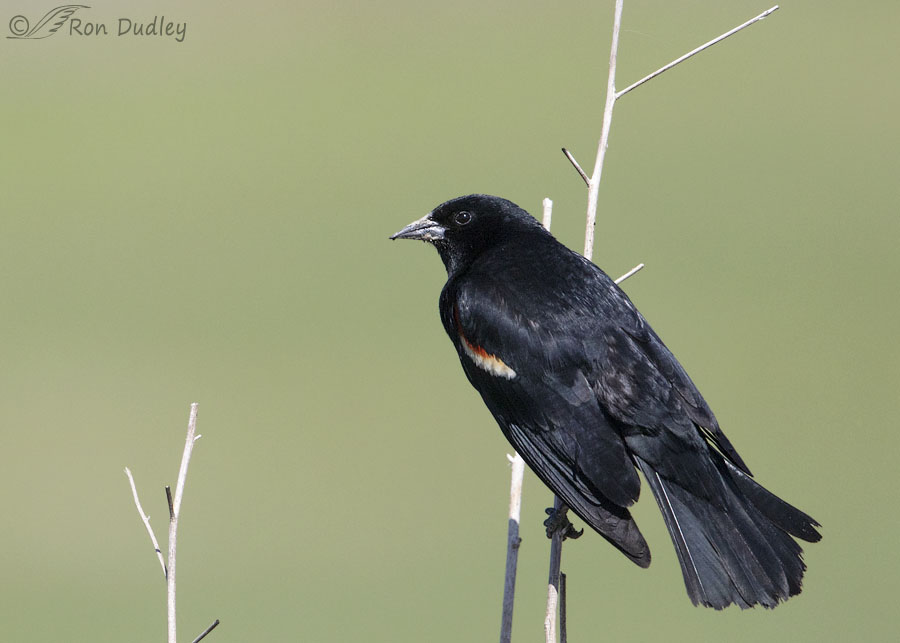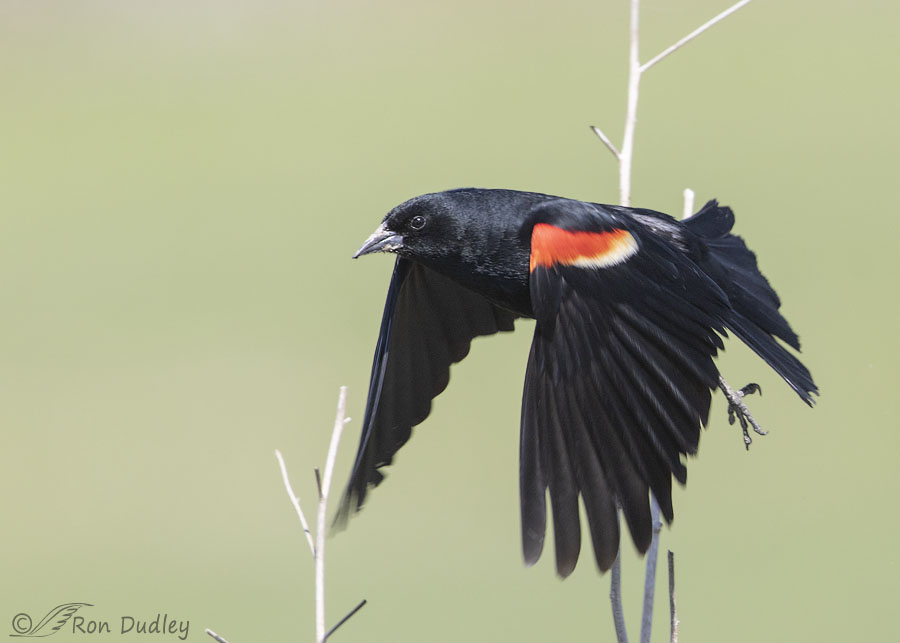Another reason I tend to shoot at higher shutter speeds than most bird photographers and this time it still wasn’t enough.

1/4000, f/6.3, ISO 500, Canon 7D Mark II, Canon EF 500mm f/4L IS II USM + EF 1.4 III Extender, not baited, set up or called in
This is a male Red-winged Blackbird from yesterday morning at Bear River MBR. I only include this photo to provide perspective on the takeoff/flight shot below. Notice that I had oodles of shutter speed to get the wings sharp if the bird took off.

1/1600, f/6.3, ISO 500, Canon 7D Mark II, Canon EF 500mm f/4L IS II USM + EF 1.4 III Extender, not baited, set up or called in
But when the deep blackness of the bird filled more of the frame at takeoff because of the open wings my camera compensated by slowing my SS to 1/1600 to get better exposure on all those blacks. The result is a brighter background and motion blur in the wings (although in this case I believe insufficient depth of field played a role too).
Since I shoot in aperture priority and like to get takeoff and flight shots I typically shoot at unusually fast shutter speeds in an attempt to cover my ass in situations like this. But this time, because my subject is so deeply black, I should have started out with a SS even faster than 1/4000. Live and learn. My technique isn’t for everyone and it doesn’t always work for me but it’s what I do.
But I still like the shot. The head is sharp enough, I like the flight pose and I don’t think motion blur in the wings is an image killer. Some folks even prefer it.
To be honest my major complaint about the image isn’t the soft wings, instead it’s the bright twig directly in front of the right wingtip. It would have been easy to remove but that’s something I prefer not to do.
Ron


Love these guys. So pretty. I got to see a hummingbird and a roadrunner today. 🙂
🙂
So, If you had a Mulligan on this image what would you do ?? 1/4000 at f/6.3 and “Auto” ISO ???
Mulligans. Now THAT’S what we need in bird photography!
Nope, I never use auto ISO. I’d just set my ISO at 800 and I’m sure that would give me enough SS.
Love the photos. Very sharp and clear. I get those twigs at times too. What can you do lol.
Not much, Jean…
Very nice closeups despite your self-critiques. We have them coming to the feeders all day long. I wish they were more aggressive so as to keep the darn ill-behaved starlings away.
Yes, starlings are very aggressive. Thanks, Lyle.
Yet another stunning bird wot I will not see. Thank you for bringing it to me. And a big yes to the photo too.
Thank you, EC.
Your technique has produced an awful lot of spectacular photographs of birds in flight (and otherwise). The image works just fine for me. An outstanding portrait of one of our more common birds whose beauty is often overlooked. I also like the fact you left that twig in the frame. These guys don’t live in a sterile environment!
Sorry about not visiting for awhile. Doggone life keeps getting in the way of stuff I want to do.
Truly hope you’re feeling well today.
Welcome back again, Wally. Yes, I understand that thing about life getting in the way…
Ron, I like the photos. I wish I could shoot with a priority other than “auto”. The bird is stunning in spite of it making a nuisance of itself in some situations. Thank you, Ron
Thanks, Alice. Once you try and then practice with other modes you’ll never go back to “auto”.
My solution is to stay in aperture priority and raise the ISO. Started with a competition between myself and another picture-taker, who challenged me to get a clean shot of a barn swallow in flight. I’ve done some concert photography, and have had to spend time getting shots of jumping guitar players in dark auditoria. .
That’s my solution too, Martha. And I should have done it here since I was only at ISO 500. But when I checked and saw my SS was 1/4000 I thought that would be fast enough assuming that it dropped when the bird took off. But this time it dropped more than I thought it would.
Last week I had a Red Wing in the back in a tree for about 20 minutes. I love their trill and discovered they have two other calls the make. I don’t know what attacks them to Sugarhouse area as there are no marshy areas here but I often hear them. This is the first time I’ve had such a long time to watch one here. Great photos and I really like the first one with the clear picture of the wing markings.
Betty, I don’t remember ever seeing them when I lived in Sugarhouse but I see them fairly often during certain times of the year here in Murray.
You’ve mad a very good point Ron. I too always use aperture priority. It’s what I’m used to and how. I think about exposure. But maybe sometimes shutter priority would be better.
Anyway good photo of a difficult subject.
Ed
“It’s what I’m used to and how I think about exposure”
That statement fits me to a T, Ed. But you said it better than I did.
Thanks Ron, nice in flight shot of one of my favorite birds. At a couple of our lakes we sometimes have flocks of 50 to possibly 100. You can imagine the sound. As you say the head is sharp and the one soft wing is what some prefer in an action shot. With posts every day once again I am thinking your back is much better? Certainly hope so.
Everett Sanborn, Prescott AZ
My back has its ups and downs but thanks to the surgery some symptoms have improved. Thanks, Everett.
What the camera decides to do isn’t always what we had in mind! 😉 Getting things adjusted to keep shutter speed up when not using shutter priority is a bit of a challenge. Red Winged Blackbirds a bit of a pain here – want to take over the feeders in the yard and I don’t enjoy their “song”…. 😉 They are, however, a beautiful bird and look nice in the cat tails they frequent in the area.. 🙂 Twig wasn’t helpful BUT still a nice shot. 🙂
Thanks, Judy. Their song is truly an acquired taste, if one ever learns to appreciate it. I don’t mind it and think it’s more appealing than that of the Yellow-headed Blackbird.
Lovely photo! They are a striking bird. They usually are cooperative…the males more so but I’ve always found it difficult to get good motion photos of them. I think you’ve explained why here for me.
Kathy, some bird photographers shoot in shutter priority partly in an effort to avoid this problem. But overall I prefer aperture priority – it’s what I know best and I’m very reluctant to switch back and forth.